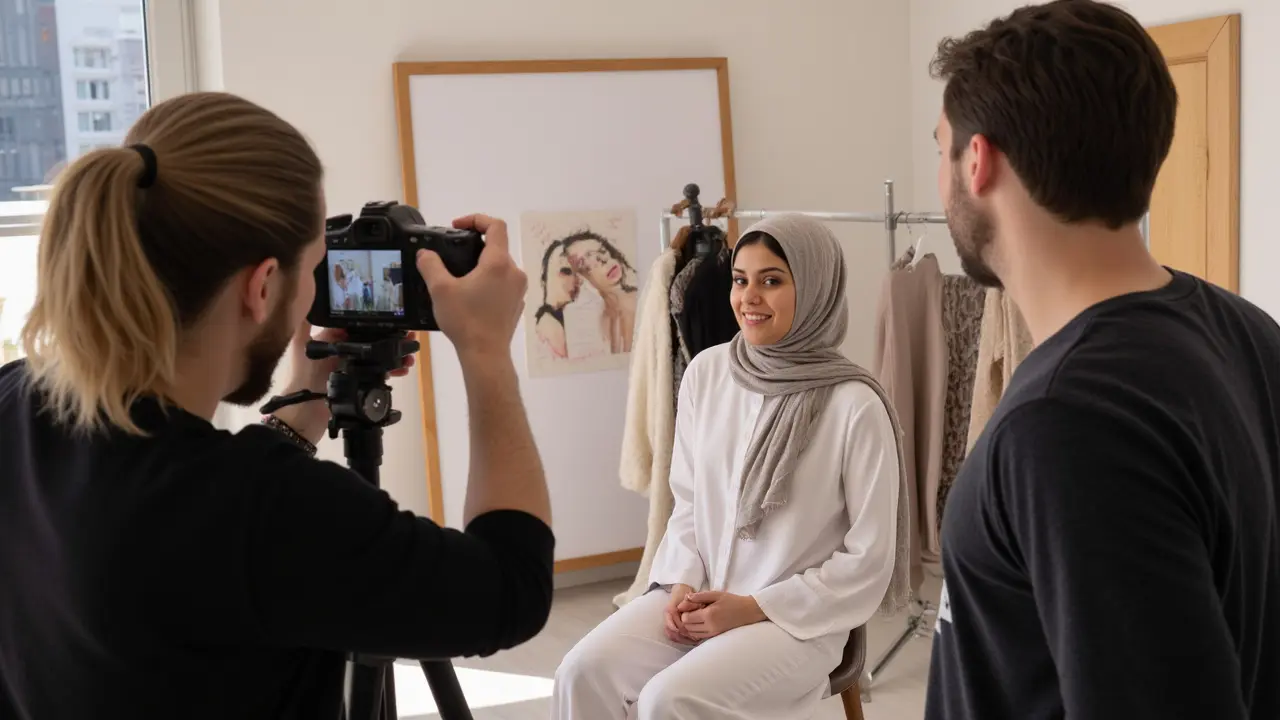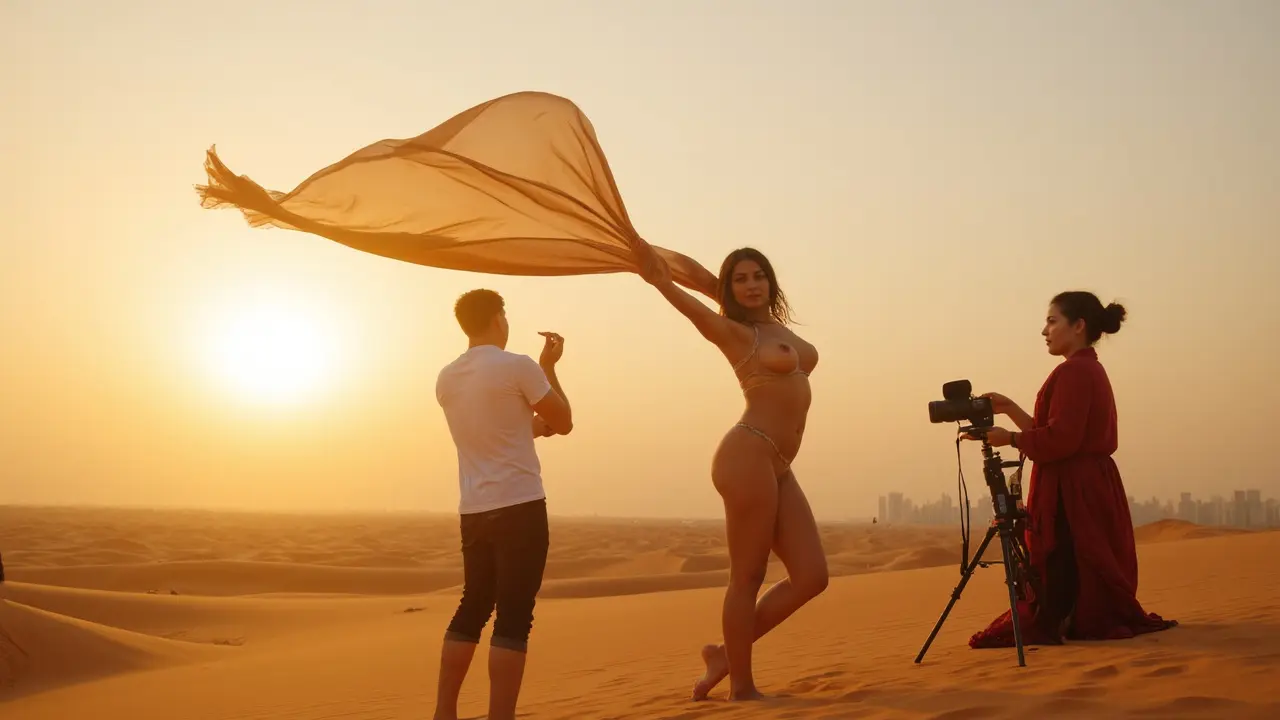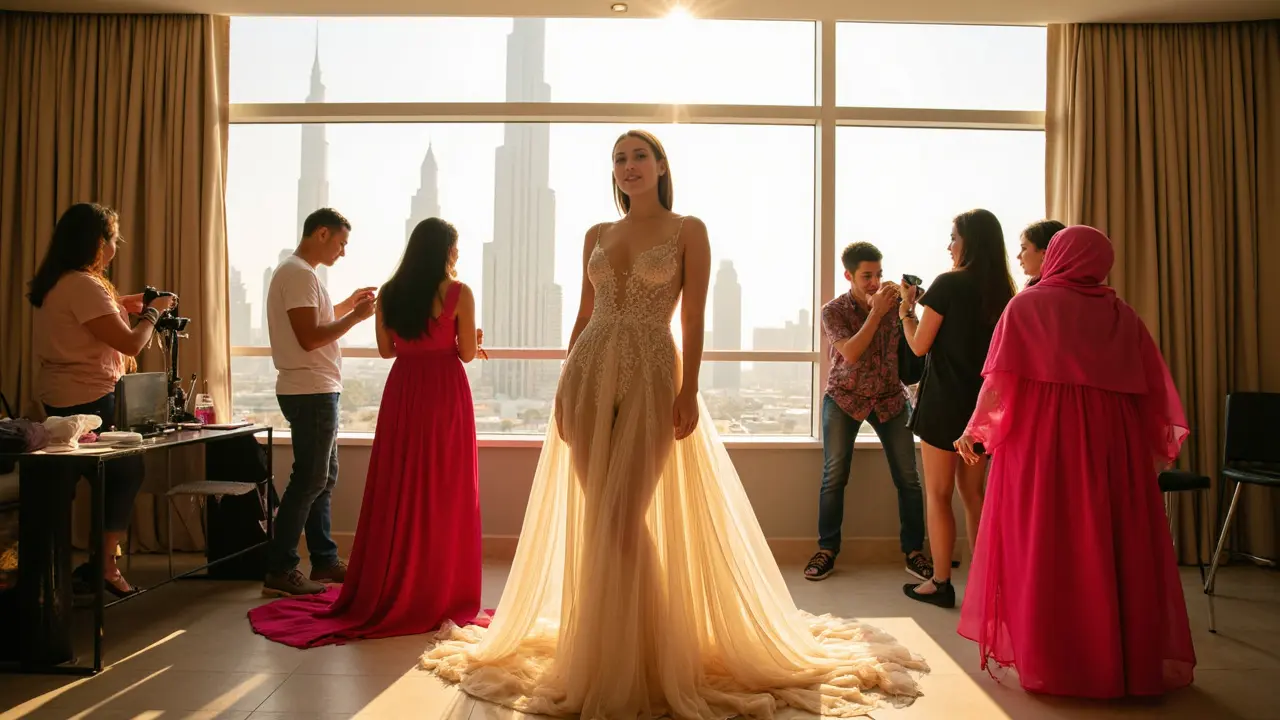The Essence of a Model Photoshoot
Ever see those impossibly perfect snaps on magazine covers and wish you knew what went into making them? That’s where a model photoshoot comes in—and trust me, it’s way more than just standing in front of a camera. At its core, a model photoshoot is a creative collaboration where a photographer, a model, and often a small crew work together to produce striking images, whether for fashion, beauty campaigns, lifestyle ads, or artistic projects. Models bring their personalities, photographers shape the mood with lighting and camera angles, and stylists and makeup artists add their magic. It feels a bit like a team sport, only the “game” is about capturing that one-in-a-million shot.
The point isn’t just to snap someone’s picture. It’s about storytelling. Each photoshoot has a vibe, a goal, and usually a concept—maybe it’s edgy street style, old Hollywood glam, or a dreamy outdoor scene at sunrise. Photoshoots often start with ‘mood boards’ (think Pinterest collages) and a ton of prepping, like picking outfits, scouting locations, and working out the best poses and expressions. Even professional models spend time nailing poses in front of mirrors and understanding the theme.
Why does this matter? Because the photos can do everything from launching a model’s career, selling a brand new lipstick to millions, or making a bold statement in art galleries. The fashion industry especially relies on model photoshoots—not just for glossy magazine spreads, but also for social media, websites, and ad campaigns. In 2024, fashion e-commerce grew a whopping 16%, and almost all of that is driven by top-notch photos. No one’s buying a jacket if the product photo looks like it was shot in a basement with a flip phone. That’s the power of a well-done shoot.
What separates a great shoot from a mediocre one? Chemistry between the team is huge. If the model feels awkward or the photographer can’t give good direction, things fall flat. Lighting is the unsung hero. Want moody shadows for a dramatic look? Overhead softboxes. Chasing golden-hour light for that warm, glowy look? You’re outside timing it just right. Details like props, makeup, and post-production editing also play starring roles. Pro tip: Most top photographers use programs like Lightroom and Photoshop, but retouching can’t fix a bored expression or slouchy posture, so the magic has to happen in real time too.
You probably didn’t guess there’s a whole etiquette to model photoshoots, either. Time is money, so punctuality matters. Models keep a simple skin routine the night before, and photographers always double-check gear to dodge any last-minute disasters. Legal stuff is a thing, too! Every shoot should have a model release form, which is a contract spelling out how the images will be used. And surprisingly, even seasoned celebs review mood boards and ask questions before big fashion shoots to make sure everyone’s on the same page.
Model photoshoots aren’t just for famous faces or big brands. Want a killer headshot for your LinkedIn or a creative portrait for your Insta? Anyone can book a shoot, and maybe that’s why the market is booming. In the US alone, freelance photographers did more than $10 billion in business last year, with a huge chunk coming from private shoots for regular people. Whether you want to dip your toes in or just satisfy your curiosity, getting to know the ins and outs of a photoshoot can seriously up your selfie game too.

What Happens During a Model Photoshoot?
Okay, picture this: you walk into a brightly lit loft, racks of clothes line one wall, makeup brushes are everywhere, and there's lots of quiet hustle. That's what a real model photoshoot feels like—a mix of nerves and excitement. So, what’s actually going on behind the scenes?
First up, there’s usually a quick meet-and-greet. The photographer recaps the plan, and everyone shares ideas or inspiration. Sometimes, models and photographers go for coffee or chat about music to break the ice. It’s not just small talk—getting comfortable makes a massive difference to how relaxed you look in photos.
Then it’s off to the makeup chair or wardrobe area. Makeup artists tend to favor subtle looks unless the shoot calls for something wild (think neon eyeshadow for a club ad). Outfits are usually pre-planned but sometimes get swapped last minute depending on the vibe or how they fit. Stylists might make tiny tweaks—a cuff here, a tuck there—before saying, “You’re good to go!”
Now for the main event: shooting. Photographers often direct the first few poses, but the best moments are usually unplanned—the casual laugh, that shift of hair, a spontaneous jump. Posing isn’t about stiff arms or unnatural smiles; it’s about telling a story and playing to your strengths. Some shoots are rapid-fire, with flashes popping every few seconds, while others are chill and slow, especially if they’re going for dreamy, candid moments.
Music is a secret weapon—classic rock, dance beats, even movie soundtracks—to help you get into the mood. Breaks? Absolutely. Hydration, snacks, and stretching keep energy up because a three-hour photoshoot is tiring, physically and mentally. And don’t forget, every little detail matters. See a misplaced hair or a wrinkled shirt? Somebody will fix it. The best team is a precise, caring one.
After the shoot wraps, there's usually a quick peek at the shots on the camera or a tablet. Everyone checks their favorites and talks about which images “pop.” It’s collaborative, not just a photographer calling the shots. Sometimes, teams celebrate a job well done with a quick coffee or share stories from other wild shoots—like the time someone stepped in wet paint or a gust of wind almost wrecked all the gear.
If you’re curious about logistics, here’s an interesting stat: on average, a fashion photoshoot produces over 500 images per session, but only 5-10 make the final cut. Editing takes days, with photographers perfecting lighting, color, and blemishes without making you look like a plastic doll. This fine balance helps brands sell authenticity, not just perfection. That’s why you’ll notice so many brands nowadays leave in freckles, scars, and even bits of messy hair. Authenticity sells—big time.
Wondering what you need to bring? A model’s basic kit almost always includes a nude bra, black and white tank tops, comfy shoes for breaks, water, snacks, face wipes, and even a book or playlist for downtime. Photographers might bring backup cameras, portable lighting rigs, and extra memory cards (losing shots because of a full card? Nightmare fuel for any pro).
Here’s something you might not expect: it’s a total myth that only ‘supermodels’ know how to pose. Even rookie models learn the basics—elongate your neck, angle your chin slightly, and switch up your hands so you don’t look blocky. Most first-timers are awkward in the first few snaps. That’s normal, and any good photographer helps you warm up and keep moving until you start having fun.
| Photoshoot Element | Pro Tip | Common Mistake |
|---|---|---|
| Posing | Use your body language to match the mood of the shoot | Stiff arms and forced smiles |
| Makeup | Start fresh-faced and add as needed | Heavy foundation or not matching skin tone |
| Lighting | Experiment with both natural and studio light | Overexposure or weird shadows |
| Outfits | Bring basics and a wildcard piece | Ignoring fit or comfort |
| Attitude | Chill, communicate, and don’t fake it | Not asking questions when you’re unsure |
If you’re thinking of booking your own model photoshoot, make sure you vibe with the photographer’s portfolio. Look for chemistry, because that helps you bring out your best self. Pricewise, it runs the gamut—a quick creative shoot might be just a couple hundred bucks, but an all-day commercial shoot easily runs into the thousands if you want hair, makeup, studio, and retouching included.
Don’t be fooled by Instagram-perfect photos. A lot of the beauty comes from comfort, good lighting, and shared ideas—not just expensive gear. That’s why some of the world’s best shots are taken in someone’s living room or a local park. It’s less about where you are, and way more about how you feel and the story you want to tell.
The takeaway? Model photoshoots are for anyone. Whether you want headshots for your new job, to build a modeling portfolio, or just because it sounds like an epic day out, it’s an experience full of creativity, laughs, and a new appreciation for the art behind every frame.

Tips and Secrets for Nailing Your Own Model Photoshoot
So, you’ve decided to jump in and either book or shoot a model photoshoot. Ready for the inside scoop that separates the memorable shoots from the snoozers?
First tip—communication is everything. Before you show up, talk about the vibe, outfits, makeup, and locations. Nothing derails a shoot faster than getting there and realizing nobody’s on the same page. Mood boards aren’t just for Pinterest addicts; they help everyone visualize the goal. Share your favorite angles or tell the photographer what you love about their past work. It builds trust and sets the stage for killer shots.
Get organized. Models should pack a variety of outfits—think layers, solid colors, and a statement piece or two. Skip logos unless you’re repping a brand (they can be distracting). Bring essential makeup staples in case of quick touch-ups or a sudden shoot outside. Don’t forget the basic kit: face wipes, snacks, and plain water (caffeine can make you jittery on camera!).
Photographers have their own essentials. Double-check batteries, lenses, light reflectors, and memory cards. If you’re shooting on location, scout for natural shade, backups in case of rain, or hidden gems for unique backgrounds. Ever noticed how so many great Instagram shoots happen in parking garages or stairwells? That’s because good light and interesting lines matter a lot more than a fancy backdrop.
Strike a balance between planning and spontaneity. Have a loose shot list, but leave space for those spur-of-the-moment ideas. Unexpected weather? Incorporate the wind into a dramatic hair shot. Found an epic wall mural? Improvise poses right there. Sometimes accidents, like puddle splashes or a sudden breeze, make the best photos.
Mind your nerves. Seriously, almost everyone feels awkward at first. The trick is to keep moving—change poses, switch facial expressions, and actually interact with the space around you. Try this classic: pretend you’re tying your shoe or adjusting an earring, then look up at the lens. It beats forced smiles every single time.
During the session, listen to feedback but don’t overthink it. Not every pose will look good on camera, and that’s fine. Sometimes just relaxing your shoulders or tilting your head changes everything. Remember how actor Chris Hemsworth talks about relaxing between takes to let his natural charisma shine? Same thing applies here—confidence is magnetic.
Here's a surprise: most of your favorite influencers take hundreds of shots to get a single upload-worthy picture. Don’t get discouraged by the rejects; instead, see them as part of the process. If you’re shooting for a brand, clarify what kind of retouching is expected. More brands want authenticity, so a few “flaws” actually make your shots pop on social media.
Protect your mental and physical energy. Try to avoid big meals right beforehand (it can bloat you or sap your energy) and watch out for dehydration—both are common mistakes. Stretch gently before starting, especially if you’re doing energetic or dynamic poses (like jumps or sitting on the floor). Consider practicing a few poses you like at home in the mirror to get used to your angles.
Posing Tip: Don’t always face the camera straight-on. Try turning slightly, shifting your weight from one foot to the other, or “smiling with your eyes” (yep, Tyra Banks was onto something). Rest your hands on your hips, neck, or even play with your hair. The point is to experiment and not overthink it.
And don’t forget about the golden rule—respect everyone’s time. Be punctual, keep your phone on silent, and show appreciation for everyone from the stylist to the assistant holding the reflector. Word gets around fast in creative circles—not just about how photogenic you are, but about your attitude on set.
There’s also the legal side: always sign a model release before shooting, especially if you plan to share or sell the images. That way, there are no surprises later if your photos appear in a campaign or on a magazine website.
Want to take your photoshoot to the next level? Some photographers use unexpected props—think balloons, vintage bikes, coffee cups, or pets—to add extra character. If you’re outdoors, think about weather-proof makeup and clothes. For indoor shoots, ask if you can play your own playlist—sometimes music is the easiest way to ditch nerves.
Don’t ignore the post-shoot hustle! Ask when and how you’ll get the final images, and be clear about editing. If you want specific edits (like smoothing out blemishes but not changing your features), say so up front. For portfolio shots, always request both high-res (for printing) and web res (for sharing online) copies.
| Common Photoshoot Costs (2025) | Low Range | High Range |
|---|---|---|
| 30-minute headshot session | $100 | $350 |
| 2-hour indoor fashion shoot | $400 | $1,200 |
| Day-long commercial campaign | $2,000 | $6,000+ |
| Add-on: Hair/Makeup artist | $100 | $500 |
| Editing/Retouching (per image) | $10 | $40 |
Something else to keep in mind: location can change the game. Shooting in a place like Los Angeles or New York? You’ll have dozens of pro photographers, endless studio options, and even unique locations like urban rooftops, graffiti alleys, and sun-drenched beaches. But even smaller cities have hidden gems—think botanical gardens, photogenic old bridges, or colorful murals tucked in side streets. Creativity trumps fancy locations every time.
Want to compare? Here’s a quick breakdown—the classic ‘model photoshoot’ versus a regular portrait shoot:
| Feature | Model Photoshoot | Portrait Session |
|---|---|---|
| Purpose | Fashion, campaigns, portfolio, editorial | Personal branding, family, graduation |
| Team | Often photographer + stylists + makeup artist | Mainly photographer; fewer people |
| Direction | Highly directed, stylized, concept-driven | Simple, classic poses |
| Editing | Extensive, often commercial-level | Basic touch-ups |
| Cost | Higher due to team/complexity | Lower, more accessible |
| Locations | Studios, creative locations | Studio or simple outdoor spots |
Ready to dive in? Whether you’re booking a session or dreaming up ideas with your crew, prepping for a model photoshoot is all about teamwork, clear communication, and rolling with surprises. Trust your creative instincts, and remember that the best photos come when you’re enjoying the moment. Strike your pose and make it fun—it’s your story to tell.
